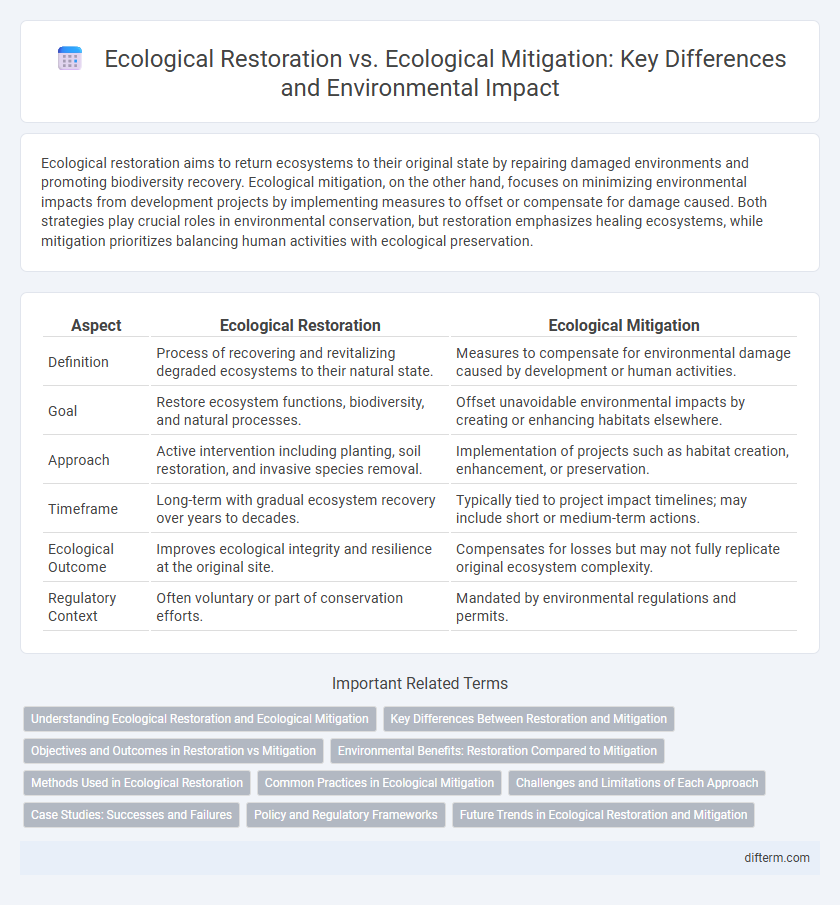Ecological restoration aims to return ecosystems to their original state by repairing damaged environments and promoting biodiversity recovery. Ecological mitigation, on the other hand, focuses on minimizing environmental impacts from development projects by implementing measures to offset or compensate for damage caused. Both strategies play crucial roles in environmental conservation, but restoration emphasizes healing ecosystems, while mitigation prioritizes balancing human activities with ecological preservation.
Table of Comparison
| Aspect | Ecological Restoration | Ecological Mitigation |
|---|---|---|
| Definition | Process of recovering and revitalizing degraded ecosystems to their natural state. | Measures to compensate for environmental damage caused by development or human activities. |
| Goal | Restore ecosystem functions, biodiversity, and natural processes. | Offset unavoidable environmental impacts by creating or enhancing habitats elsewhere. |
| Approach | Active intervention including planting, soil restoration, and invasive species removal. | Implementation of projects such as habitat creation, enhancement, or preservation. |
| Timeframe | Long-term with gradual ecosystem recovery over years to decades. | Typically tied to project impact timelines; may include short or medium-term actions. |
| Ecological Outcome | Improves ecological integrity and resilience at the original site. | Compensates for losses but may not fully replicate original ecosystem complexity. |
| Regulatory Context | Often voluntary or part of conservation efforts. | Mandated by environmental regulations and permits. |
Understanding Ecological Restoration and Ecological Mitigation
Ecological restoration focuses on repairing damaged ecosystems to their original state by reestablishing native species, natural processes, and habitat functions, thereby enhancing biodiversity and ecosystem services. In contrast, ecological mitigation involves compensatory actions that offset environmental damage caused by development projects, often through habitat creation, enhancement, or preservation elsewhere. Understanding the differences between ecological restoration and ecological mitigation is critical for effective environmental management and sustainable land-use planning.
Key Differences Between Restoration and Mitigation
Ecological restoration aims to return degraded ecosystems to their original state by reestablishing native species, natural processes, and habitat functions, while ecological mitigation primarily focuses on offsetting environmental damage caused by development projects through compensatory actions. Restoration emphasizes long-term ecosystem recovery and biodiversity enhancement, whereas mitigation often involves creating or enhancing habitats to balance impacts rather than replicating original ecosystem conditions exactly. The success of restoration is measured by ecosystem health and resilience, whereas mitigation success depends on compliance with regulatory requirements and achieving equivalency in ecological value.
Objectives and Outcomes in Restoration vs Mitigation
Ecological restoration aims to return degraded ecosystems to their original, pre-disturbance states, enhancing biodiversity, soil health, and water quality through natural processes. Ecological mitigation focuses on compensating for environmental damage caused by development or human activity, often creating new habitats or improving existing ones to offset losses. Restoration outcomes prioritize long-term ecosystem resilience and functionality, while mitigation results may vary in ecological equivalency and often emphasize regulatory compliance rather than full recovery.
Environmental Benefits: Restoration Compared to Mitigation
Ecological restoration actively rebuilds native ecosystems, enhancing biodiversity, improving soil stability, and boosting carbon sequestration at a greater scale compared to ecological mitigation. Restoration projects restore natural processes and habitat connectivity, leading to long-term environmental resilience and improved water quality. Mitigation often compensates for environmental damage but rarely achieves the full spectrum of ecological functions and benefits that comprehensive restoration provides.
Methods Used in Ecological Restoration
Ecological restoration employs methods such as reforestation, wetland reconstruction, soil stabilization, and invasive species removal to revive natural habitats and enhance biodiversity. Techniques like planting native vegetation, restoring hydrological flows, and improving soil quality are integral to restoring ecosystem functions. These methods contrast with ecological mitigation, which often involves compensatory actions to offset environmental damage rather than fully restoring the original ecosystem.
Common Practices in Ecological Mitigation
Common practices in ecological mitigation involve habitat creation, restoration, and enhancement to compensate for environmental damage caused by development projects. Techniques include wetland restoration, reforestation, and invasive species management, aiming to maintain biodiversity and ecosystem services. These practices are regulated through environmental impact assessments and often require long-term monitoring to ensure ecological balance is achieved.
Challenges and Limitations of Each Approach
Ecological restoration faces challenges including high costs, long timeframes, and difficulties in fully replicating original biodiversity and ecosystem functions. Ecological mitigation often struggles with inadequate replacement ratios and spatial mismatches, leading to limited effectiveness in offsetting environmental damage. Both approaches are constrained by regulatory complexities and uncertainties in ecosystem responses to interventions.
Case Studies: Successes and Failures
Ecological restoration projects in the Florida Everglades demonstrate significant success by reestablishing native wetlands and improving biodiversity, whereas mitigation efforts in the Mississippi Delta reveal challenges with incomplete habitat replacement and delayed ecological benefits. Case studies reveal that restoration efforts often provide more comprehensive ecosystem recovery by addressing root causes of degradation, while mitigation tends to focus on compensating for habitat loss through simpler, less effective interventions. Long-term monitoring of restoration and mitigation projects highlights that adaptive management and community involvement are critical factors influencing success rates in environmental recovery initiatives.
Policy and Regulatory Frameworks
Ecological restoration involves policies focused on rehabilitating degraded ecosystems to their natural state, often mandated by environmental protection laws such as the U.S. Endangered Species Act and the European Union's Natura 2000 network. Ecological mitigation policies, embedded in frameworks like the Clean Water Act's mitigation banking and the National Environmental Policy Act (NEPA), require developers to compensate for environmental damage through habitat creation or enhancement elsewhere. Regulatory agencies like the U.S. Environmental Protection Agency (EPA) and international bodies enforce these frameworks to ensure balance between development and ecosystem conservation.
Future Trends in Ecological Restoration and Mitigation
Future trends in ecological restoration emphasize integrating cutting-edge technologies such as remote sensing and AI to enhance habitat recovery and biodiversity monitoring. Ecological mitigation is evolving towards more stringent regulatory frameworks that prioritize net positive environmental outcomes through innovative offsetting strategies and adaptive management. Both fields increasingly focus on climate resilience and ecosystem services to ensure long-term sustainability and restoration success.
ecological restoration vs ecological mitigation Infographic

 difterm.com
difterm.com